Removing the Tree-of-Heaven (TOH):
During the winter, arborist companies will often take advantage of the slow season and perform needed tree removal services for clients. However, these professionals know when dealing with the tree-of-heaven (Ailanthus altissima) the off-season is only a suitable time for removal if a previous herbicide treatment was applied during the late summer or early fall seasons (i.e., mid-July to mid-October). Then during the off-season, the trees can be cut & removed from mid-November thru April (Figure 1).
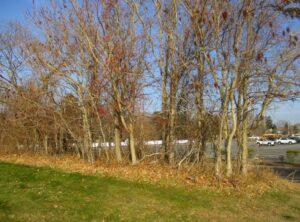
(Fig. 1) The cutting & removal of this cluster of tree-of-heaven trees should only be done in the winter if herbicide treatments were applied during the late summer or fall seasons. (Photo Credit: Steven K. Rettke, Rutgers Coop. Ext.)
If a tree-of-heaven (TOH) is cut & removed without first using an herbicide & waiting at least 30 days, then the tree will respond with potentially dozens of trunk sprouts & root suckers that could emerge 50-feet from a large parent tree. Applying the herbicide during mid-July to mid-October when the tree is most actively translocating photosynthates to the root system will allow the herbicide to move further distances most effectively through the phloem. This will help reduce problems with trunk sprouts & root suckers which this tree species is notoriously known to produce (Figure 2).

(Fig. 2) Herbicides to TOH should be applied from mid-July to mid-October. The photo shows the onset of fall coloration & indicates the end of effective herbicide treatment for the season. (Photo Credit: Steven K. Rettke, Rutgers Coop. Ext.)
Tree-of-Heaven Spread & Distribution:
Ailanthus altissima is native to northeast China & was intentionally introduced into Philadelphia during the 1780’s as a shade tree. Today this species is highly invasive, grows extremely fast (e.g., often thought of as a weed tree) & has been considered a nuisance species long before the invasion of the spotted lanternfly (Fig. 3). The TOH is established throughout much of the northeastern US & extends deep into the midwestern states. The tree is also found extensively in California where it was introduced in the 1850’s (Fig. 4). Given time, the invasive spotted lanternfly planthopper (also native to China) will eventually locate most tree-of-heaven trees within the country (Fig. 5).
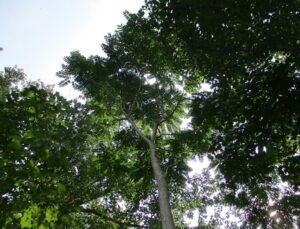
(Fig. 3) The fast growing tree-of-heaven is not shade tolerant & must reach for the heavens to stay above the competition. (Photo Credit: Steven K. Rettke, Rutgers Coop. Ext.)
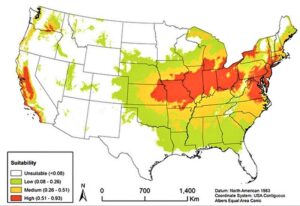
(Fig. 4) Potential spread of the spotted lanternfly in the USA is typically associated with the distribution of the tree-of-heaven species. (Photo Credit: Wakie et al 2019, Journal of Economic Entomology).
Although the TOH can grow well in the full sun as an individual tree, it is most often found growing in clusters along sun/shade borders. This includes rights-of-way such as roads, railroads & agricultural field wind breaks. The tree will not be found growing in densely shaded areas. Clusters produced by root suckers from the parent tree are genetic clones of each other & will be either all male or all female trees (Fig. 6).
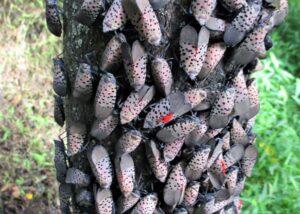
(Fig. 5) The invasive weed tree (tree-of-heaven) became even more notorious after the discovery of the spotted lanternfly within PA in 2014. (Photo Credit: Steven K. Rettke, Rutgers Coop. Ext.)
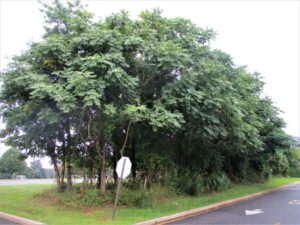
(Fig. 6) A cluster of tree-of-heaven trees growing along a former woods-lined border next to a parking lot. The former woods at far-left were removed & replaced with athletic fields. (Photo Credit: Steven K. Rettke, Rutgers Coop. Ext.)
Herbicide Timing & Follow-up:
To achieve best results when applying herbicides to the TOH, then the mid-July to mid-October optimum treatment timing needs to be followed. If this treatment window is missed, then the herbicide will not achieve maximum root injury & applications will only provide above ground shoot injuries or “top kill.” The TOH is a difficult tree to remove because of its resprouting capabilities & wide-ranging root system. Even when treatment timing is accomplished, follow-up treatments the next year or two will still be required to attain complete success.
Treating cut tree stumps with an herbicide can be effective at killing trunk sprouts with some tree species, but such an approach will be a mistake with the TOH because of the extensive root suckering (Fig. 7). Furthermore, it is critical to remember to wait at least 30 days after treatment before cutting & removing the tree to allow the systemic herbicide time enough to translocate to the more distant roots. Once the tree is removed the translocation of herbicide into the roots is greatly slowed or curtailed.
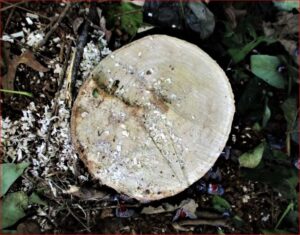
(Fig. 7) Applying a herbicide treatment to the cut stump of a tree-of-heaven will not prove effective against root suckers. (Photo Credit: Steven K. Rettke, Rutgers Coop. Ext.)
Three Different Herbicide Treatment Options:
There are several different treatment techniques that can be used when applying herbicides. When only a few trees are targeted for removal, then just a handful of simple items are needed. The tree height, stem diameter & number of trees involved will determine if some or all the items in the photograph will be needed (Fig. 8). They include a hand-can sprayer, a squirt bottle, a cloth tape measure & a hatchet. Furthermore, the equipment required is also determined by the treatment application method. They include (1) foliar, (2) basal bark, or (3) hack & squirt and these methods will be described in the sections further below.
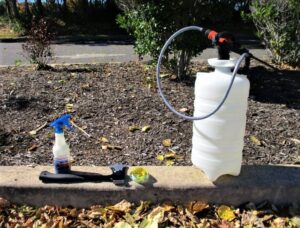
(Fig. 8) Some simple tools & spray equipment used to apply herbicides to a tree-of-heaven. Naming items from left to right: Spray bottle; Hatchet; Tape measure; & Hand-can sprayer. (Photo Credit: Steven K. Rettke, Rutgers Coop. Ext.)
Foliar Application:
When the tree-of-heaven trees targeted are no taller than 8-10 feet & they are growing in tight clusters, then hand-can or backpack sprayers can be used to apply foliar herbicides (Fig. 9). The non-selective herbicides glyphosate (e.g., AquaNeat (brand name)) & triclopyr amine (water based) (e.g., Garlon 3A (brand name)) are two effective active ingredients that can be sprayed alone, but work best as a mixture. Both materials have aquatic labeling. A spreader-sticker surfactant will need to be added unless the product label states it comes premixed. Since both materials are non-selective, foliar applications are best used only if non-target vegetation can be avoided. Like all TOH herbicide treatments the best timing will be from mid-July to the onset of fall color or mid-October in NJ.
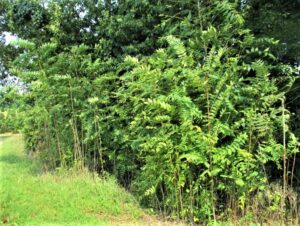
(Fig. 9) Foliar treatments of herbicides can easily be applied onto this small, short, & tight cluster of tree-of-heaven with hand-can or backpack sprayers. (Photo Credit: Steven K. Rettke, Rutgers Coop. Ext.)
Basal Bark Application:
When the tree-of-heaven trees targeted have stems diameters ≤ 6 inches, then squirt bottles or hand-can/backpack sprayers can apply herbicides to the lower 12 to 18 inches around the entire stem circumference (Fig. 10). Triclopyr ester (e.g., Garlon 4 Ultra (brand name)) is an oil-based herbicide that has proven effective when the proper treatment timing is followed. (Triclopyr ester or Garlon 4 Ultra is a restricted use material & requires a pesticide licence to purchase & use). This stem treatment method is also often used the next year as a follow-up after a foliar application & targets the surviving stems. It is an excellent choice if trees are tall & non-target vegetation contamination is more likely from foliar applications (Fig. 11). When stem diameters exceed 6-inches, then the frill or hack-and-squirt application technique is a better option.
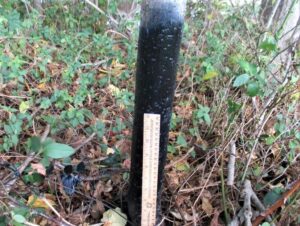
(Fig. 10) Tree-of-heaven basal stem treatment with triclopyr ester (oil-based) herbicide. TOH with a 3-inch stem diameter showing herbicide applied around circumference at 18 inches down to the base. (Photo Credit: Steven K. Rettke, Rutgers Coop. Ext.)
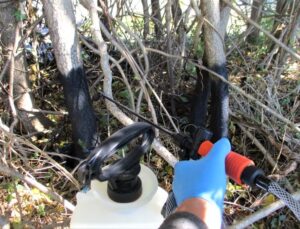
(Fig. 11) A cluster of 2-3-inch diameter TOH receiving basal bark treatments of triclopyr ester herbicide. Most of these trees had canopies above 15 feet. (Photo Credit: Steven K. Rettke, Rutgers Coop. Ext.)
Hack-and-Squirt Application:
When applying herbicides to larger TOH trees > 6-inches DBH, then the water-based materials glyphosate (e.g., AquaNeat (brand name)) or triclopyr amine (e.g., Garlon 3A (brand name)) can be used with the hack-and-squirt technique. A photo of the trunk of a large TOH with a DBH (diameter at breast height) greater than 6-inches (Fig. 12). Hack-and-squirt applications can also be done with smaller trees, but they should have a least a 1-inch stem diameter. This method requires the use of a hatchet to make spaced cuts with intact bark around the circumference of the stem. The number of hatchet cuts is determined by 1-cut per inch of stem diameter, with a minimum of 2-cuts. Using a cloth tape measure is an easy way to determine the tree circumference at breast height & then calculating the DBH. Hence, using the photo example provided: Circumference (27.5 in.) ÷ π (3.14) = DBH (8.6 in.) Therefore, there should be 8 or 9 hatchet cuts around the circumference of this tree (Fig. 13).
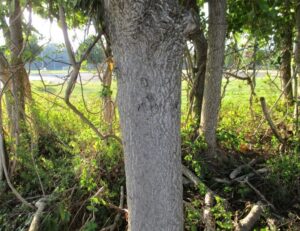
(Fig. 12) A tree-of-heaven with DBH greater than 6-inches. The number of hatchet cuts around the circumference is one-cut per inch of DBH. (Photo Credit: Steven K. Rettke, Rutgers Coop. Ext.)

(Fig. 13) Using a cloth tape measure is an easy way to determine the tree circumference at breast height & then calculating the DBH. Hence, 27.5 in. / 3.14 = 8.6 in. (Photo Credit: Steven K. Rettke, Rutgers Coop. Ext.)
The hatchet strikes angled at approximately 45° against the tree trunk are best applied at only a few feet above the ground. Be certain not to girdle the stem, but to leave spaces between the cuts (Fig. 14). This is critical to continue to maintain translocation of the systemic herbicide deep into the root system through the tree’s vascular system. Immediately use the squirt bottle to fill the cuts with the herbicide. Avoid excessive run-off down the stem (Fig. 15).
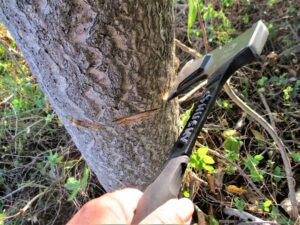
(Fig. 14) Using hatchet to make cuts into TOH stem a few feet above ground. Striking at a 45 degree angle helps to create a cut-space to fill the herbicide. (Photo Credit: Steven K. Rettke, Rutgers Coop. Ext.)

(Fig. 15) Be certain not to girdle the stem, but to leave spaces between cuts. Use the squirt bottle to spray & fill the herbicide into the cuts. (Photo Credit: Steven K. Rettke, Rutgers Coop. Ext.)
Review:
Again, as is true with all the various methods discussed above, it is especially important to wait at least 30 days after the herbicide application before the TOH tree is cut & removed. Remember, applying an herbicide to an already cut stump may prevent some trunk sprouts, but will not provide satisfactory control of excessive root suckering. Also, it will be required to monitor the treated area the following year to make additional follow-up treatments where needed.
Reference: PennState Extension; Invasive Weeds Fact Sheet: Tree-of-Heaven; Prepared by David R. Jackson, Forest Resources Educator, 2019.

